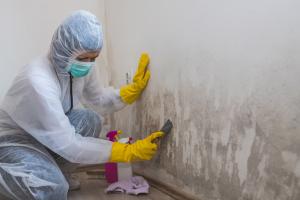Ultimate Guide to Removing White Mold: Step-by-Step Solutions

-
Quick Links:
- 1. Introduction
- 2. Understanding White Mold
- 3. Health Risks of White Mold
- 4. Identifying White Mold
- 5. Tools and Materials Needed
- 6. Step-by-Step Cleaning Process
- 7. Preventing White Mold Growth
- 8. Case Studies
- 9. Expert Insights
- 10. FAQs
1. Introduction
White mold is a common problem that can affect indoor spaces, particularly in damp or humid environments. Unlike other types of mold, white mold can often go unnoticed until it has become a significant issue. This comprehensive guide will provide you with effective solutions for cleaning white mold, ensuring a safe and healthy living environment.
2. Understanding White Mold
White mold is a type of fungus that appears as a white powdery substance. It typically thrives in moist areas and can be found on a wide range of surfaces, including walls, ceilings, and furniture. Understanding its characteristics is essential for effective removal.
2.1 What is White Mold?
White mold is primarily composed of fungal spores and can sometimes be confused with mildew. However, it has distinct differences in texture and growth patterns. It often indicates a moisture problem in the environment.
2.2 Where Does White Mold Grow?
Common places for white mold to develop include:
- Basements
- Bathrooms
- Kitchens
- Attics
- Behind furniture or carpets
3. Health Risks of White Mold
Exposure to white mold can lead to various health issues, especially for those with respiratory conditions or weakened immune systems. Symptoms can range from mild allergies to more severe respiratory problems.
3.1 Common Symptoms
Some common symptoms of mold exposure include:
- Coughing and sneezing
- Skin irritations
- Headaches
- Respiratory issues
4. Identifying White Mold
Identifying white mold is crucial for effective treatment. Here are some tips to help you recognize it:
4.1 Visual Identification
Look for:
- Powdery white spots
- Fluffy white patches
- Discoloration on surfaces
4.2 Smell Test
White mold often carries a musty odor, which can be a tell-tale sign of its presence.
5. Tools and Materials Needed
Before you start cleaning, gather the following tools and materials:
- Protective gloves
- Mask or respirator
- Sponge and scrub brush
- Bucket
- Cleaning solution (vinegar, bleach, or commercial mold remover)
6. Step-by-Step Cleaning Process
Follow these steps to effectively clean white mold:
6.1 Preparation
Ensure the area is well-ventilated to avoid inhaling mold spores. Wear protective gear before starting the cleaning process.
6.2 Apply Cleaning Solution
Use a mixture of water and vinegar or a commercial mold remover. Apply it to the affected area using a sponge or spray bottle.
6.3 Scrub the Area
Gently scrub the surface to remove the mold. For stubborn patches, allow the cleaning solution to sit for a while before scrubbing.
6.4 Rinse and Dry
After scrubbing, rinse the area with clean water and dry it thoroughly to prevent future mold growth.
7. Preventing White Mold Growth
To prevent white mold from returning, consider these tips:
- Maintain indoor humidity levels below 60%
- Use dehumidifiers in damp areas
- Ensure proper ventilation in bathrooms and kitchens
- Fix any leaks promptly
8. Case Studies
Here are a couple of real-world examples of successful white mold removal:
8.1 Case Study 1: Residential Cleanup
A homeowner discovered white mold in their basement. By following the steps outlined in this guide, they successfully removed the mold and implemented prevention strategies.
8.2 Case Study 2: Commercial Facility
A local gym faced a white mold issue in their locker rooms. After a thorough cleaning and improved ventilation, they eliminated the problem and ensured a safe environment for their clients.
9. Expert Insights
We reached out to mold remediation experts for their insights on tackling white mold. Here’s what they had to say:
9.1 Expert Recommendation
Dr. Jane Smith, a leading mold specialist, emphasizes the importance of addressing moisture issues as the first step in mold prevention.
9.2 Tools for Effective Mold Removal
Experts recommend using eco-friendly cleaning solutions to minimize health risks while effectively removing mold.
10. FAQs
1. Can I clean white mold myself?
Yes, with the right tools and precautions, you can effectively clean white mold yourself.
2. What is the best cleaning solution for white mold?
Vinegar and commercial mold removers are both effective options for cleaning white mold.
3. Does white mold always mean there's a moisture problem?
Yes, white mold typically indicates an underlying moisture issue that needs to be addressed.
4. How can I prevent white mold from returning?
Maintaining low humidity and ensuring proper ventilation are key to preventing white mold growth.
5. Is white mold harmful?
While not as toxic as some other molds, white mold can still pose health risks, especially to sensitive individuals.
6. How do I know if it’s white mold or mildew?
White mold appears as fluffy patches, while mildew is usually flat and powdery.
7. Can I use bleach to clean white mold?
Yes, bleach can effectively kill mold, but it’s essential to use it safely and in a well-ventilated area.
8. Should I call professionals for mold removal?
If the mold covers a large area or if you have health concerns, it's advisable to seek professional help.
9. What are the signs of mold in my home?
Look for discoloration, musty odors, and health symptoms like coughing or sneezing.
10. How can I tell if I have a mold problem in my basement?
Check for dampness, discoloration on walls, and musty smells, which are all indicators of a mold issue.
Random Reads
- How to refresh a webpage
- How to register device on amazon
- The ultimate guide to safely cutting cement backer board
- How to remember electrical resistor color codes
- How to sync google contacts with android
- How to sync messages in viber
- Understanding sos only mode
- Unblock websites
- Unblock youtube school
- How to start windows in safe mode